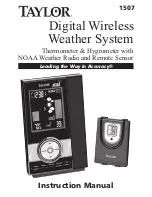
Detailed Installation Instructions
There are two main components of the Wireless RainSensor: the Receiver and the
Sensor/Transmitter. The Receiver is installed adjacent to or within the cabinet of the
irrigation system controller. The Sensor/Transmitter is installed outdoors where it is
exposed to unobstructed rainfall.
Mounting the Receiver
1.
Always mount the Receiver FIRST, adjacent to the controller with either the
provided stainless steel screws or double-sided foam tape. The connection wire
cable is 20" (50cm) long, so before attaching the Receiver, make sure the wires
will easily reach the controller’s connection terminals.
Wiring the Receiver
There are two parts involved in wiring the Receiver:
Part 1:
Attach the Receiver control wires (similar to hard-wired sensors).
Part 2:
Attach the low-voltage power wires to supply 24 VAC to the Receiver.
Part 1 - Control Wire Connection
The Receiver control wires are used to interrupt the common wire of the valves or they
can be connected directly to the sensor input terminals of the controller (if provided).
1.
Disconnect power to the controller.
2.
Follow applicable wiring procedure
A
or
B
or
C
.
Note:
The following diagrams are representations only and do not depict actual
controller layouts. Refer to the installation instructions provided with your controller for
specific wire connection information.
A. Controllers with sensor inputs (with or without pump/master valve):
Refer to
Figure 6
. Find the controller sensor terminals (generally marked “Sensor”,
“SEN” or “S”) and directly connect the White and Brown* wires to these terminals
in any order. There may be a jumper wire or tab connecting the terminals that
must be removed and/or a sensor bypass/control switch that must be activated.
4
Figure 6
Red
Brown
*
Common From Valves
To Valves
Irrigation System Controller
White
Red
*
Note:
Use Yellow wire in place of Brown
if a Normally Open sensor is required.






























